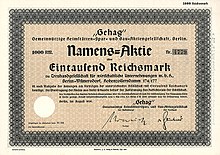GEHAG
| GEHAG GmbH
|
|
|---|---|
| legal form | GmbH |
| founding | 1924 |
| Seat |
Berlin , Germany |
| management |
|
| Number of employees | 0 |
| sales | 127.4 million euros (2017) |
| Branch | Housing company |
| As of December 31, 2017 | |
The GEHAG GmbH is a privatized housing companies in Berlin . The company was founded in April 1924 as a non-profit Heimstätten-, Spar- und Bau-Aktiengesellschaft . GEHAG is part of the Deutsche Wohnen SE group of companies .
history
The company, founded in Berlin in 1924, had numerous housing estates built in various districts, especially in the 1920s and 1930s. In 1998 GEHAG was partially privatized. 25% and one share remained with the State of Berlin. In autumn 2005, the US financial investor Oaktree Capital Management took over 85% of the shares in GEHAG GmbH from HSH Nordbank . In July 2007, the listed Deutsche Wohnen AG took over the majority of the company's shares. At the end of 2017, GEHAG was managing 13,102 residential units, mainly in the Berlin-Brandenburg area.
Buildings on behalf of GEHAG
The residential buildings and settlements of GEHAG are considered to be architecturally and socially trend-setting: Hufeisensiedlung (1925), Waldsiedlung Zehlendorf (1926) and the settlement on Possweg also in Berlin-Zehlendorf (1933/1934), Onkel Toms Hütte (1926–1932), residential area Carl Legien (1929) and Gropiusstadt (1962–1975). You are connected to Bruno Taut , Otto Rudolf Salvisberg and other architects.
Furthermore, the company had a roughly one kilometer long contiguous residential development built in the area of Buschallee , Gartenstraße, Sulzfelder Straße and Kniprodeallee (today Hansastraße ), also based on plans by Bruno Taut (1925–1930). The buildings were structurally changed during the GDR era, but after careful reconstruction they are on the list of monuments.
Other GEHAG residential building ensembles shown in the Berlin Monument List are: in the Britz district in the Karree Fritz-Reuter-Allee / Parchimer Allee / Gielower Straße / Malchiner Straße, in Berlin-Tegel ("Freie Scholle" settlement), in the Berlin-Falkenhagener Feld area ( housing estate on Germersheim place) and in Berlin light field , the Finnish house settlement on Blackertzweg / Hildburghauser road.
Web links
Individual evidence
- ↑ a b c Annual financial statements for the financial year from 01/01/2017 to 12/31/2017 in the Federal Gazette. Retrieved April 28, 2019 .
- ↑ Core data of the GEHAG Group ( memento of the original from September 23, 2015 in the Internet Archive ) Info: The archive link has been inserted automatically and has not yet been checked. Please check the original and archive link according to the instructions and then remove this notice. at Deutsche Wohnen AG
- ↑ Deutsche Wohnen merges with the GEHAG Group. (No longer available online.) July 3, 2007, formerly in the original ; accessed on August 29, 2010 (German). ( Page no longer available , search in web archives ) Info: The link was automatically marked as defective. Please check the link according to the instructions and then remove this notice.
- ↑ Residential complex Buschallee 8–23, 24–68, 71–84, 94–107 / Gartenstrasse 12/13, 22–25A / Hansastrasse 174/176 / Sulzfelder Strasse 2–6; 1925–1930 by Bruno Taut
- ↑ Housing complex Fritz-Reuter-Allee 75–95 / Parchimer Allee 45–59, 63 / Gielower Strasse 28-28F, 32-32E / Malchiner Strasse 70–118; 1932/1933 from the Gehag design office
- ↑ Freie Scholle settlement Talsandweg 3–20, 22 / Waidmannsluster Damm 60A – 64 / Erholungsweg 50–58; 1937 from the planning department of GEHAG
- ↑ Housing estate on Germersheimer Platz: Germersheimer Platz 1–10D / Falkenseer Chaussee 267–269, Germersheimer Weg 30–78 / Merziger Straße 3–7, Zweibrücker Straße 17–23, 25–42, 44, 46; 1939–1941 from the construction department of GEHAG including the sgraffiti murals by Willy Robert Huth
- ^ Finnenhaussiedlung Berlin-Lichterfelde; 1958 in the monument database of the Senate Department for Urban Development and the Environment



